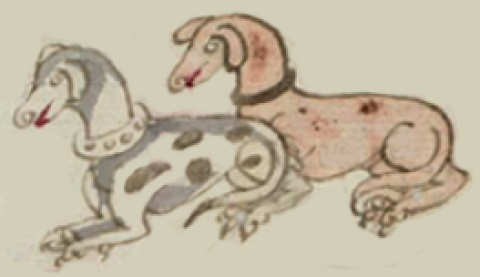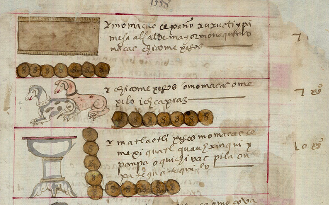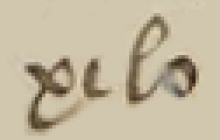perro (CST17)
This painting of the simplex glyph for the term perro (a loanword from Spanish taken into Nahuatl) includes two dogs in profile, facing the viewer’s left, both of them lying down. The one on the left is white with gray spots. The one on the right is slightly tucked behind the spotted dog. Its color is somewhat pink. Both dogs have their mouths open slightly, with red tongues visible. Their paws have long claws.
Stephanie Wood
The companion text refers to an expenditure of 7 pesos for hiring the dogs to guard sheep. For more on the Codex Sierra, see Kevin Terraciano’s study (2021), 111, 147.
Stephanie Wood
1550–1564
Jeff Haskett-Wood
perros, pastores, guardianes, ovejas

perro, a dog, https://nahuatl.wired-humanities.org/content/perro
perro
Stephanie Wood
Códice Sierra-Texupan, plate 17, page dated 1558. Origin: Santa Catalina Texupan, Mixteca Alta, State of Oaxaca. Kevin Terraciano has published an outstanding study of this manuscript (Codex Sierra, 2021), and in his book he refers to alphabetic and “pictorial” writing, not hieroglyphic writing. We are still counting some of the imagery from this source as hieroglyphic writing, but we are also including examples of “iconography” where the images verge on European style illustrations or scenes showing activities. We have this iconography category so that such images can be fruitfully compared with hieroglyphs. Hieroglyphic writing was evolving as a result of the influence of European illustrations, and even alphabetic writing impacted it.
https://bidilaf.buap.mx/objeto.xql?id=48281&busqueda=Texupan&action=sear...
The Biblioteca Digital Lafragua of the Biblioteca Histórica José María Lafragua in Puebla, Mexico, publishes this Códice Sierra-Texupan, 1550–1564 (62pp., 30.7 x 21.8 cm.), referring to it as being in the “Public Domain.” This image is published here under a Creative Commons license, asking that you cite the Biblioteca Digital Lafragua and this Visual Lexicon of Aztec Hieroglyphs.


